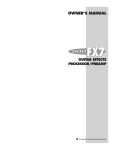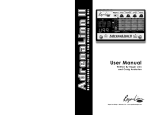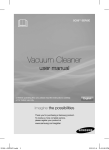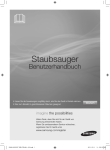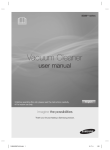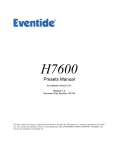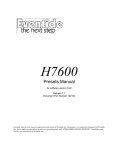Download DOD Acoustic1 Owner`s manual
Transcript
OWNER'S MANUAL A Harman International Company IMPORTANT! CAUTION RISK OF ELECTRIC SHOCK DO NOT OPEN A T T E N T I O N : RISQUE DE CHOC ELECTRIQUE - NE PAS OUVRIR W A R N I N G : TO REDUCE THE RISK OF FIRE OR ELECTRIC SHOCK DO NOT EXPOSE THIS EQUIPMENT TO RAIN OR MOISTURE The symbols shown above are internationally accepted symbols that warn of potential hazards with electrical products. The lightning flash with arrowpoint in an equilateral triangle means that there are dangerous voltages present within the unit. The exclamation point in an equilateral triangle indicates that it is necessary for the user to refer to the owner’s manual. These symbols warn that there are no user serviceable parts inside the unit. Do not open the unit. Do not attempt to service the unit yourself. Refer all servicing to qualified personnel. Opening the chassis for any reason will void the manufacturer’s warranty. Do not get the unit wet. If liquid is spilled on the unit, shut it off immediately and take it to a dealer for service. Disconnect the unit during storms to prevent damage. U.K. MAINS PLUG WARNING A moulded mains plug that has been cut off from the cord is unsafe. Discard the mains plug at a suitable disposal facility. NEVER UNDER ANY CIRCUMSTANCES SHOULD YOU INSERT A DAMAGED OR CUT MAINS PLUG INTO A 13 AMP POWER SOCKET. Do not use the mains plug without the fuse cover in place. Replacement fuse covers can be obtained from your local retailer. Replacement fuses are 13 amps and MUST be ASTA approved to BS1362. FOR YOUR PROTECTION, PLEASE READ THE FOLLOWING: WATER AND MOISTURE: Appliance should not be used near water (e.g. near a bathtub, washbowl, kitchen sink, laundry tub, in a wet basement, or near a swimming pool, etc). Care should be taken so that objects do not fall and liquids are not spilled into the enclosure through openings. POWER SOURCES: The appliance should be connected to a power supply only of the type described in the operating instructions or as marked on the appliance. GROUNDING OR POLARIZATION: Precautions should be taken so that the grounding or polarization means of an appliance is not defeated. POWER CORD PROTECTION: Power supply cords should be routed so that they are not likely to be walked on or pinched by items placed upon or against them, paying particular attention to cords at plugs, convenience receptacles, and the point where they exit from the appliance. SERVICING: The user should not attempt to service the appliance beyond that described in the operating instructions. All other servicing should be referred to qualified service personnel. FUSING: If your unit is equipped with a fuse receptacle, replace with only same type fuse. Refer to replacement text on the unit for correct fuse type. signal processing Introduction .........................................................................................................2 About the Pictorial Guide Indicators................................................................2 Warranty.........................................................................................................2 SECTION 1 - GETTING STARTED..........................................................................4 Supplying Power ..................................................................................................4 Front Panel Controls ............................................................................................5 PROGRAM AND BANK SELECTOR FOOTSWITCHES ........................................5 EFFECT SELECTOR BUTTONS (DIGITAL FX) .....................................................5 TUNER .........................................................................................................5 EFFECT GROUPS .............................................................................................5 EFFECT SELECTOR BUTTONS (PREAMP)..........................................................5 STORE BUTTON..............................................................................................6 DISPLAY .........................................................................................................6 DATA WHEEL...................................................................................................6 CLIP LED .........................................................................................................6 INPUT KNOB ..................................................................................................6 OUTPUT KNOB...............................................................................................6 Rear Panel Connections .......................................................................................6 INSTRUMENT INPUT ......................................................................................6 NOTCH FILTER................................................................................................6 JAM-A-LONG™ INPUT ....................................................................................6 HEADPHONE OUTPUT ....................................................................................6 LEFT / MONO OUT.........................................................................................6 RIGHT OUT .....................................................................................................6 VOLUME CONTROLLER INPUT .......................................................................7 AC POWER INPUT...........................................................................................7 POWER CORD STRAIN RELIEF .........................................................................7 Hooking Up .........................................................................................................7 SECTION 2 - PROGRAMMING THE ACOUSTIC ONE ...........................................8 Navigating The Acoustic One ..............................................................................8 Using The Footswitches .......................................................................................8 Editing Programs .................................................................................................9 Storing Programs .................................................................................................10 Bypassing/Tuner Mode ........................................................................................11 A Word About Mono Operation..........................................................................11 Using A Controller With The Acoustic One.........................................................11 About the Acoustic One's Effects.........................................................................12 EQUALIZERS....................................................................................................12 CHORUSES .....................................................................................................12 FLANGERS.......................................................................................................12 PHASERS .........................................................................................................12 TREMOLOS .....................................................................................................12 MONO DELAYS...............................................................................................13 PONG DELAYS ................................................................................................13 TAP DELAYS ....................................................................................................13 Factory Program List............................................................................................14 Specifications .......................................................................................................14 Acoustic One Block Diagram ...............................................................................15 Acoustic One owner's manual 1 signal processing Introduction Welcome to the world of the DOD Acoustic One! You have purchased the finest acoustic signal processor and preamp of its kind; hardly a surprise when it comes from DOD. The Acoustic One gives you both functional flexibility and tonal excellence, driven by our proven effects processing technology. The Acoustic One's palette of effects gives you compression, noise gate, 3-band EQ, Notch Filter, chorus, flanger, phaser, pitch shifter, tremolo, detuner, mono delay, stereo 2-tap delay, and reverb. With 30 factory Programs and 30 user Programs, you'll always have a good starting point for creating any sound you want, and plenty of space to store your own custom configurations. About the Pictorial Guide Indicators This manual can be used in two ways: you can read the text on the right side of the page, or you can follow the pictorial guides in the left margin. The pictorial guides show you how to get through each procedure without reading a lot of text. There are a few steps that require reading, but they will be indicated. Following is a key that describes the pictorial guide symbols: ......This symbol means you need to read the indicated item DATA ..............Turn the Data wheel ......Press the indicated button Warranty 1. The warranty registration card must be mailed within ten days after purchase date to validate this warranty. 2. DOD warrants this product, when used solely within the U.S., to be free from defects in materials and workmanship under normal use and service. 3. DOD liability under this warranty is limited to repairing or replacing defective materials that show evidence of defect, provided the product is returned to DOD WITH RETURN AUTHORIZATION, where all parts and labor will be covered up to a period of two years. A Return Authorization number may be obtained from DOD by telephone. The company shall not be liable for any consequential damage as a result of the product’s use in any circuit or assembly. 4. Proof-of-purchase is considered to be the burden of the consumer. 5. DOD reserves the right to make changes in design or make additions to or improvements upon this product without incurring any obligation to install the same on products previously manufactured. 2 Acoustic One owner's manual signal processing 6. The foregoing is in lieu of all other warranties, expressed or implied, and DOD neither assumes nor authorizes any person to assume any obligation or liability in connection with the sale of this product. In no event shall DOD or its dealers be liable for special or consequential damages or from any delay in the performance of this warranty due to causes beyond their control. DOD™ and Acoustic One are registered trademarks of DOD Electronics Corporation. The information contained in this manual is subject to change at any time without notification. Some information contained in this manual may also be inaccurate due to undocumented changes in the product or operating system since this version of the manual was completed. The information contained in this version of the owner's manual supersedes all previous versions. Acoustic One owner's manual 3 signal processing SECTION 1 - GETTING STARTED Supplying Power The Acoustic One, like any piece of computer hardware, is sensitive to voltage drops, spikes and surges. Interference such as lightning or power "brownouts" can seriously, and in extreme cases, permanently damage the circuitry inside the unit. Here are a few tips that will help you get the best possible performance out of your Acoustic One, while avoiding damage: • Always make sure you have a "clean" power source for connecting to the Acoustic One. This means that the AC power line you connect to the Acoustic One should be as free from voltage fluctuations and RF interference as possible. In recording environments, "clean" power is also important in preventing AC hum or buzz from getting to tape. • Use a good quality spike/surge suppressor (also called a power strip). This is an inexpensive solution to all but the most severe AC line conditions. A good quality power strip can save you a lot of money in repair bills because they prevent large spikes and surges from reaching your equipment. Also in this category (but more expensive), are rackmount power supplies. Some of these (like the DOD 828) have retractable light tubes and RF filtering. • Although more expensive, AC line conditioners offer the best protection from improper line voltages. Line conditioners constantly monitor the AC line for excessively high or low voltages and instantaneously compensate to deliver a consistent voltage to the connected equipment. • Always make sure that your audio lines are as far as possible from power cables. This will further prevent noise, hum, and stray magnetic fields from entering your signal path. If audio and power lines must run close to each other, try to avoid running them parallel to one another. 4 Acoustic One owner's manual signal processing Front Panel Controls 1 2 3 4 5 6 7 8 9 10 11 The front panel of the Acoustic One is laid out in a simple and straightforward way to make programming as easy as possible. Functions of each section are: 1) PROGRAM AND BANK SELECTOR FOOTSWITCHES- These footswitches access the User Programs in the Acoustic One and let you change User Banks. (Factory Programs can be accessed by using ther Data Wheel). 2) EFFECT SELECTOR BUTTONS (DIGITAL FX)- Let you select an effect group for editing, or bypass the group completely. This group includes: Master Level, Reverb, Delay, Detune, Pitch Shift, Phase, Tremolo, Chorus, or Flange. 3) EFFECT GROUPS - The Acoustic One's effects are divided into 12 groups and labeled on the front panel. When lit, the LED in each group indicates that an effect in the group is active. 4) TUNER - When the Acoustic One is in bypass mode, the chromatic tuner is engaged. 5) EFFECTS SELECTOR BUTTONS (PREAMP) - This row of four buttons lets you change your basic preamp section settings. The preamp section consists of: Noise Gate,EQ, and Compressor groups. Acoustic One owner's manual 5 signal processing 6) STORE BUTTON - Stores your custom Programs in the user memory location you select. 7) DISPLAY - The LED display in Program mode, shows which Bank and Program is curently selected. In Edit mode, it shows the number and/or status of the selected effect. 8) DATA WHEEL - In Program Mode, use the Data wheel to scroll through Programs. In Edit Mode, use it to change the setting of the effect groups. 9) CLIP LED- The Clip LED lights when clipping occurs at the input of the Acoustic One. To eliminate clipping, reduce the setting of the Input Level control, or the Master Level Parameter. 10) INPUT KNOB - Controls the level of the signal at the Acoustic One's input stage. 11) OUTPUT KNOB - Controls the overall output level of both the Left and Right outputs and the Headphone output. Rear Panel Connections 1 2 3 4 5 6 7 LEFT/MONO OUT RIGHT OUT VOLUME 8 9 Manufactured in the USA by A Harman International Company INPUT NOTCH FILTER JAM-A-LONG HEADPHONE OUT POWER INPUT 9V 500 mA The Acoustic One's rear panel is even simpler than the front, and that means faster hookup time for you. The rear panel has: 1) INSTRUMENT INPUT - Plug your instrument in here. 2) NOTCH FILTER - Reduces feedback problems by selecting problem frequencies, and attenuating them 12 dB. Rotate this control to change which frequency is selected. Range is from 100Hz to 3.5kHz. 3) JAM-A-LONG™ INPUT - This stereo mini jack lets you connect your tape deck or CD player headphone output to the Acoustic One for personal jam sessions. The Jam-A-Long™ signal is mixed with your instrument signal at both the main and headphone outputs so you can play along with your favorite tunes. 4) HEADPHONE OUTPUT - This stereo mini phone plug is for your headphones. The overall headphone level is controlled by the Output level knob. 5) LEFT / MONO OUT - For stereo applications, this is the Left main output. Use this jack for mono applications. 6) RIGHT OUT - For stereo applications, this is the Right main output. For mono applications, leave this jack unconnected. 6 Acoustic One owner's manual signal processing 7) VOLUME CONTROLLER INPUT - This 1/4" connector is used to connect most volume pedals or 0/+5v controller pedals to the Acoustic One for real-time control of volume functions. 8) AC POWER INPUT - Connect the supplied AC power adapter to this jack. Use only the adapter supplied with the Acoustic One. Use of any other adapter may damage the unit. 9) POWER CORD STRAIN RELIEF - This clip prevents the AC power cord from being accidentally pulled out. Hooking Up DO NOT APPLY POWER TO THE ACOUSTIC ONE UNTIL INSTRUCTED. 1) STEREO: Connect the Left and Right outputs to a pair of guitar amplifiers or the inputs of a mixing console. If you're using guitar amps, set the tone controls flat (no boost or cut) and balance the levels between them. If you're using a console, pan the Acoustic One input channels hard left and right and turn down the high frequency EQ for best results. MONO: Connect the Left output to a guitar amplifier or input of a mixing console. Acoustic One owner's manual 2) Connect your instrument to the input of the Acoustic One. 3) OPTIONAL: Connect a volume type or 0/+5v controller pedal to the Controller input of the Acoustic One. Make sure the pedal is connected before you apply power to the Acoustic One. 4) Power up the Acoustic One by connecting the supplied AC adapter between the Acoustic One and a power outlet. 5) Play your instrument and watch the Clip LED on the Acoustic One carefully as you set the Input knob. Turn up the input level until the Clip LED begins to light and back off the knob slightly. When the Input knob is set properly, the Clip LED should not flicker on the loudest passages. It is important to remember that In bypass/tuner mode, the clip LED will not light. 6) Set the output level as desired. 7 signal processing SECTION 2 - PROGRAMMING THE ACOUSTIC ONE Navigating The Acoustic One The Acoustic One is designed to be both easy to program and flexible. The structure of an Acoustic One program is logical, and doesn't require a lot of time to master. To select Programs in the Acoustic One: DATA 1) After you power up, use the Data wheel to scroll through the Programs. As you scroll, the effect group and footswitch LEDs turn on and off. These LEDs indicate which effects are used in each Program, and which Program in the Bank is selected. There are 12 effect groupings printed on the front panel of the Acoustic One. Seven are digital effect groups (delay, reverb, etc.) , and five cover the preamp section (compression, gate, and EQ). Each group has its own LED that indicates the status of each group. If the Status LED is lit continuously, an effect in the indicated group is active. If the LED is not lit, no effects in the group are active. If the LED is flashing, edit mode is active, and effects in the group can be selected using the Data wheel. Directly below each vertical group are the Effect Selector buttons. These buttons allow you to select and/or bypass effects in the Acoustic One. The following will happen when you use the Effect Selector buttons: • When you select a bypassed effect, its group LED begins flashing and the display shows a double dash (- -), indicating that the effect is selected, but is currently bypassed. (Pressing the Select button again activates the effect.) • When you select an active effect, its group LED begins flashing and the display shows the number of the currently selected effect. (Pressing the button again bypasses the effect.) When lit, the User LED below the display indicates that the current Program is a User Program. When the LED is not lit, the current Program is a permanent Factory Program. Using The Footswitches The Acoustic One's pedalboard consists of four footswitches: the far right footswitch is the Bank selector, and the remaining three are Program selectors. A Bank is a group of three Programs. There are 10 User Banks in the Acoustic One, each with 3 Programs for a total of 30 User Programs. There are also 30 Factory Programs that can be selected using the Data wheel only. User Programs in any of the Banks can be recalled in one of two ways: • Pressing the Bank select footswitch followed by footswitch 1, 2, or 3, or: • turning the Data wheel in Program mode. 8 Acoustic One owner's manual signal processing To select Programs using the footswitches: 1) After you power up, the Acoustic One defaults to Program mode. Select a Bank by pressing the Bank selector footswitch. The display shows the selected bank number on the left side of the display and a dash on the right. The display looks something like this: BANK 2_ 1 2 or 3 2) Press footswitch 1, 2, or 3. The dash in the display changes to show the number of the Program you selected. The display looks something like this: 23 NOTE: If a new Program number is not selected within 5 seconds after pressing the Bank select button, the display returns to its previous setting. Editing Programs As you become more familiar with the Acoustic One, you may want to modify certain Programs to better suit your needs. Fortunately, the Acoustic One is flexible enough to give you everything you need without being difficult to program. The following procedure is an example of how to modify your Programs. Suppose that Program 32 (which has a Tremolo effect), sounds close to what you want, but you want a faster Tremolo speed. Here's how to change it: DATA 1) Use the Data wheel, or the Bank and Program selector footswitches to select Program 32. 2) Press the Tremolo effect group button. The Tremolo group Status LED begins flashing and the display reads: 16 3) Look at the front panel Tremolo groupings to locate the effect you want. In this case, you'll see that Tremolo Fast, can be found between 19 and 21 in the Tremolo Group. DATA 4) Use the Data wheel to scroll until the the display reads: 19 Acoustic One owner's manual 9 signal processing NOTE: When you change the selected Parameter from the stored value, a decimal point appears in the bottom right corner of the display and the Store LED lights. That's it! You can manipulate any effect setting in the Acoustic One by pressing the associated Effect button on the front panel and turning the Data wheel. The Effect Group buttons toggle the effects on and off with each successive press of the button. When you're editing Programs, be sure to pay attention to the flashing Status LEDs. This helps you keep track of where you are in the menus. IMPORTANT: If you want to store your custom Program so you can use it later, follow the procedure below. Storing Programs The Acoustic One helps you remember whether or not you've stored the Program you're working on by lighting the Store LED under the bottom right corner of the display when the selected Program has been edited. Remember that if you change any settings in a Program, you have to store the Program into a User memory location. Otherwise, all your changes will be lost. To store a Program into a memory location: User Store 2) Use the Data wheel to select the User location where you want to store the Program. DATA User 1) Press the Store button. The Store LED begins flashing and the User LED lights (if not lit already). Store 3) Press the Store button again to store the Program in the location you selected. After the storing procedure is complete, the Acoustic One returns to normal operation at the new Program location. NOTE: Factory Programs can't be overwritten. When you modify a Factory Program and store it in memory, the Program is stored in the corresponding number location in the User Program section. Bypassing The Acoustic One's bypass functions are very simple. To bypass individual effects: 1) From Program mode, decide which effect you want to bypass and press the Select button twice. The display reads: For all effects: -. For EQs: 0º Press the effect Select button to toggle the effect in and out of bypass. 10 Acoustic One owner's manual signal processing REMEMBER: The decimal point indicates that the value shown in the display is not the stored value. To bypass the selected Program and access Tuner mode: 1) Press the currently selected Program footswitch on the pedalboard. The footswitch's Status LED flashes and the display reads: bp Immediatley after, a double dash (- -) will appear in the display, and the Tuner LED will come on. The Acoustic One is now in tuner mode. Upon reading the input note, the display will tell you what the note is. If only the green LED (located in the bottom row of effect module LEDs) lights, that note is in tune. If any LED to the left of the green LED is lit, the note is flat. If any LED to the right of the green LED is lit, the note is sharp. For the best tuning results, tune to the 12th fret harmonic. If a muted output is desired while tuning, press and hold the footswitch when entering bypass until the display briefly reads: OF, from this point, you can begin tuning. The tuning reference can also be set at either: E, Eb, or D from the double-dash (- -) prompt, by rotating the data wheel up or down. To exit Bypass/Tuner mode, press any footswitch. A Word About Mono Operation The Acoustic One can operate in either stereo or mono. It is important to remember that the way you connect your cables to the outputs can affect the output mode. Here's a simple way to remember how it works: • If only one output cable is connected, the Acoustic One switches to mono mode. Otherwise, it operates in stereo. Using A Controller With The Acoustic One The Acoustic One is able to respond to most volume pedal outputs or 0/+5v controller pedals to control volume effects in real time. To set up the Acoustic One for this application: 1) Disconnect the power to the Acoustic One. 2) Connect the output or the 0/+5v control output of a volumetype controller pedal (such as the DOD FX17) to the Volume Controller input on the rear panel of the Acoustic One. 3) Sweep the pedal through its entire range to calibrate pedal. REMEMBER: make sure the pedal is connected to the Acoustic One before you apply power. It is also important to note that the controller's pedal position affects all Programs, even after you change Programs. If a Program doesn't sound the way you saved it, check the position of the controller pedal. Acoustic One owner's manual 11 signal processing About the Acoustic One's Effects The Acoustic One has a large library of effects that covers virtually every possible need. Because they are so numerous, we have designed the following charts to give you as much relevant information as possible, while omitting tedious or obvious details about each module's setting. For example, Detuners, Pitch Shifters, and Noise Gate are not shown because their Module names are relatively self explanatory. The Fast Swell and Slow Swell Gates in the Noise Gate menu have attack times of 500 ms and 1000 ms respectively. The Acoustic One effects include: EQUALIZERS * When Low, Mid, or High bands are bypassed, the frequency gain level is set flat at 0dB. Name Low Mid High FREQUENCY 200Hz- Can be cut or boosted from -12dB to +12dB, in increments of 2dB. 1.5kHz- Can be cut or boosted from -12dB to +12dB, in increments of 2dB. 9kHz- Can be cut or boosted from -12dB to +12dB, in increments of 2dB. CHORUSES Chorus # 1 2 3 4 Name Speed/Level Speed/Level Speed/Level Speed/Level Slow Medium Fast 0.1/25 .25/25 2.0/25 0.15/25 .35/25 3.5/25 0.1/50 .25/50 2.0/50 0.15/50 .30/50 3.5/50 Flanger # 1 2 3 4 Name Speed/Fback Speed/Fback Speed/Fback Speed/Fback Slow Medium Fast .1/40 .3/50 .7/60 .15/40 .35/50 .8/60 .15/50 .40/60 1.0/75 .2/50 .40/60 1.0/80 Phaser # 1 2 3 4 Name Speed/Fback Speed/Fback Speed/Fback Speed/Fback Slow Medium Fast .1/60 .25/60 .9/40 .1/70 .25/70 1.0/50 .15/80 .45/70 1.5/50 .15/80 .45/80 2.0/60 FLANGERS PHASERS TREMOLOS *All Tremolos have a fixed Depth rate. 12 Tremolo # 1 2 3 Name Slow Medium Fast Speed 2.0 Hz 5.0 Hz 7.5 Hz Speed 3.0 Hz 6.0 Hz 8.0 Hz Speed 4.0 Hz 7.0 Hz 9.0 Hz Acoustic One owner's manual signal processing MONO DELAYS Delay # 1 2 3 4 5 6 7 8 9 Name fback/level fback/level fback/level fback/level fback/level fback/level fback/level fback/level fback/level 100 200 250 300 350 400 500 0/15 0/15 0/15 0/15 0/15 0/15 0/15 0/30 0/30 0/30 0/30 0/30 0/30 0/30 0/50 0/50 0/50 0/50 0/50 0/50 0/50 15/15 15/15 15/15 15/15 15/15 15/15 15/15 15/30 15/30 15/30 15/30 15/30 15/30 15/30 15/50 15/50 15/50 15/50 15/50 15/50 15/50 30/15 30/15 30/15 30/15 30/15 30/15 30/15 30/30 30/30 30/30 30/30 30/30 30/30 30/30 30/50 30/50 30/50 30/50 30/50 30/50 30/50 Delay # 1 2 3 4 5 6 7 8 9 Name fback/level fback/level fback/level fback/level fback/level fback/level fback/level fback/level fback/level 100/200 150/300 200/400 250/500 0/15 0/15 0/15 0/15 0/30 0/30 0/30 0/30 0/50 0/50 0/50 0/50 15/15 15/15 15/15 15/15 15/30 15/30 15/30 15/30 15/50 15/50 15/50 15/50 30/15 30/15 30/15 30/15 30/30 30/30 30/30 30/30 30/50 30/50 30/50 30/50 Delay # 1 2 3 4 5 6 7 8 9 Name fback/level fback/level fback/level fback/level fback/level fback/level fback/level fback/level fback/level 100/200 200/300 300/400 400/500 0/15 0/15 0/15 0/15 0/30 0/30 0/30 0/30 0/50 0/50 0/50 0/50 15/15 15/15 15/15 15/15 15/30 15/30 15/30 15/30 15/50 15/50 15/50 15/50 30/15 30/15 30/15 30/15 30/30 30/30 30/30 30/30 30/50 30/50 30/50 30/50 PONG DELAYS TAP DELAYS Acoustic One owner's manual 13 signal processing Factory Program List Following is a list of the factory Programs available in the Acoustic One. They are divided into Banks with a suggested application for each sound. As always, don't be afraid to experiment. PROGRAM # 01- Bright Detune/Delay 02- 12 String Hall 03- Classical Hall PATCH DESCRIPTIONS Detune with 500ms Delay Uncanny 12 String Simulation Standard Classical Guitar Sound 11- Big Strum 12- Live Room 13- Ping Pong Flange Used for open chord strumming Punchy EQ with a subtle room reverb Flange with Left/Right Delay 21- Chorus Slap 22- Octave Down 23- Slide Lead Light Chorus with Slapback Delay Pitch Shifted down an Octave for Bass notes Ideal for Open tuning slide playing 31- Dry and Compressed 32- Cowboy Tremolo 33- Bright Light Chorus Tightly compressed uneffected sound Western Ballad Vibrato effect Light Chorus, with boosted High EQ 41- Very “Mod”ern 42- Slow Sweep 43- Deep Detune A very modulated Chorus Wide-Slow Flange An extreme Detune, with Hall Reverb 51- Detuned Delay 52- Pschadelic 53- Triplets Optimized for usage on muted chords An exaggerated Phaser with Delay Used to produce synchopated Apreggios 61- Chord Swell 62- Tremolo Swell 63- 12 String Swell Produces a Volume Pedal type effect A short volume swell attack pre-Tremolo Synth swell type effect 71- Mid Scoop Detune 72- Big Arena 73- Chorus for Chords Modern Acoustic Patch Large Reverb sound A subtle Chorus effect for rhythm 81- New Phase 82- Modern Classical 83- Spacey Classical Phaser with Delay Euphoric Reverb and Chorus patch Phaser and Delay with a Large Hall Reverb 91- Steel String Solo 92- A Fifth Above 93- Chorus Bounce An ideal soloing patch with Chorus and Delay The Input note is pitch-shifted a 5th above A Rich, Deep Chorus with Left/Right Delay Specifications A/D Resolution: 18 Bit D/A Resolution: 16 Bit DSP: 24 bit Frequency Response: 20Hz to 16kHz Signal to Noise Ratio: -87dB Power Supply: DOD PS750, 9 VAC @ 750 ma 14 Acoustic One owner's manual Input Input Buffer Acoustic One owner's manual µ Pot Compressor Notch Filter Multiplex Attn PreEmphasis LEDs A/D D/A Switches Micro Controller DSP RAM DeEmphasis Jam-A-Long Head Phone Output Right Out Left Out signal processing Acoustic One Block Diagram 15 DOD Electronics Corporation 8760 South Sandy Parkway Sandy, Utah, 84070 Telephone (801) 566-8800 FAX (801) 566-7005 International Distribution: 3 Overlook Drive, Unit 4 Amherst, New Hampshire 03031 U.S.A. FAX (603) 672-4246 Acoustic One™ is a registered trademark of DOD Electronics Corporation Copyright © 1996 DOD Electronics Corporation Printed In U.S.A.6/96 Manufactured in the U.S.A. Acoustic One 18-2167-A OS 1.0 A Harman International Company


















